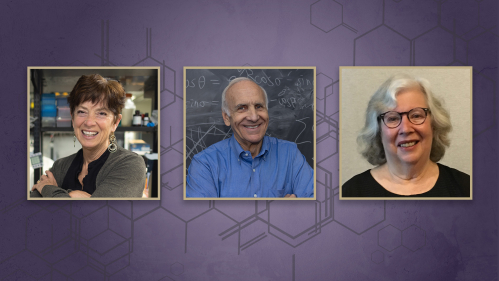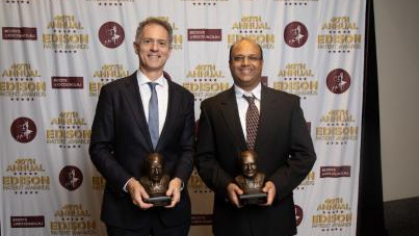National Academy of Sciences Elects Three From Rutgers

Thomas Banks, Helen Berman and Monica Driscoll are recognized for their distinguished, original research
Three Rutgers faculty members – whose pioneering work includes developing an alternate theory of the evolution of the universe, creating one of the world’s first open-access libraries of proteins and investigating the mysteries of the biology of healthy aging – have been elected as members of the National Academy of Sciences.
The trio from Rutgers-New Brunswick’s School of Arts and Sciences – Thomas Banks, a Distinguished Professor in the Department of Physics and Astronomy; Helen Berman, the Board of Governors Distinguished Professor Emerita in the Department of Chemistry and Chemical Biology; and Monica Driscoll, a Distinguished Professor in the Department of Molecular Biology and Biochemistry – were among 120 new members and 23 international members elected May 2 to the scientific society.
In its announcement, the academy said those elected are being recognized for “their distinguished and continuing achievements in original research.”
The academy, a private, nonprofit institution established under a congressional charter signed by President Abraham Lincoln in 1863, recognizes achievement in science by election to membership. Members provide scientific advice to the federal government and other organizations.
Banks, a theoretical physicist, has made wide contributions to topics ranging from particle physics to string theory. For the past 20 years, he and Willy Fischler of the University of Texas-Austin have been developing a variation on the theory of how the universe was created.
The existing belief, known as inflation theory, suggests that the universe, after a period of explosive growth following the Big Bang, slowed down, sped up and presently is continuing to do so. Banks’ theory, which differs in the details, is part of a new theoretical framework he is creating called “Holographic Space-Time.”
He founded his idea on the original theories and observations of black holes made by the late British physicist Stephen Hawking and others. In the scenario, Banks agrees the universe is expanding. But the details of what happened in the past differ.
Every bit of matter seen in the universe today originated as a tiny black hole, according to his theory. If proven correct, the theory could account for the existence of the mysterious, nonluminous material known as dark matter believed to be linked to the universe’s expansion. Banks’ theory could also explain why there is more matter than the opposite-charged antimatter in the universe today – a perplexing lack of what should be in balance that makes existence possible.
“It’s a great honor to be recognized by such a distinguished group of scholars,” Banks said.
Banks earned his undergraduate degree from Reed College in Oregon and his doctoral degree from the Massachusetts Institute of Technology and served as a postdoctoral fellow at Tel Aviv University. He joined the Rutgers faculty in 1989.
Berman started her research career as an X-ray crystallographer, which led her into structural biology. She determined the structures of nucleic acid fragments and protein nucleic acid complexes and has done several systematic studies of the interactions of these molecules. Her lab at Rutgers produced the first single crystal structure of a defined sequence collagen. Collagen is the most abundant protein in humans, forming long molecular ropes that strengthen and support tendons, bones, skin and internal organs.
Long before the concept of “open access” in science became fashionable, Berman, as early as the 1960s, saw the need for an international, openly available repository of protein structures. She recognized that sharing information about early investigations into biomolecular structures would accelerate discovery, benefiting all.
In 1971, she helped establish the international archive of the structures of biological macromolecules known as the Protein Data Bank (PDB) at Brookhaven National Laboratory in New York. She brought it to Rutgers in 1998. Today, scientists worldwide are working together, using 3D protein structure information stored in the PDB, to discover and develop vaccines and drugs that will protect the world population. The PDB has grown from being an archive with only a handful of structures to one hosting about 200,000 protein, DNA and RNA structures that are used by scientists for free to unlock the mysteries of human disease.
“I am so honored to be elected, especially since it is recognition of both my own research and the many years I worked on creating systems that enable scientific discovery by others,” Berman said.
Berman, who continues to provide support in her role as the PDB’s director emerita, earned her undergraduate degree from Barnard College and her doctoral degree from the University of Pittsburgh and served as a postdoctoral fellow at the University of Pittsburgh. She joined the Rutgers faculty in 1989.
Driscoll, a molecular neuro-geneticist, seeks to discover the ways in which humans might live longer while remaining in good health. She does so by studying C. elegans, the common roundworm that, while possessing a body that is structurally simple, shares many genes and molecular pathways with humans.
She began her career studying the fundamental biology of how roundworms sense touch. That work led unexpectedly to the discovery that roundworms’ neurons degenerate by hyperactivating, similar to what happens in human brain cells during a stroke. That motivated Driscoll to look more closely at the basic biology of aging and the destruction of brain cells in diseases like Alzheimer’s and Parkinson’s. She found that aging in roundworms is complex in nature but includes focusing on the gradual loss of muscle mass, strength and function, mirroring what is seen among elderly humans. She began promoting a concept among colleagues known as “healthspan” – a period preceding any impairing decline when body systems function normally in a manner reflecting general good health. What if, she wondered, this span of good health could be extended? Further work has led to insights into the importance of exercise as an anti-aging strategy.
In 2019, Driscoll put 3,600 worms aboard the SpaceX Falcon 9 rocket to the International Space Station to study muscle decline on space flights and to further her research into aging and neurodegeneration. Recently, she has found that roundworms’ brain cells wall off and discard toxic accretions to protect the brain, which may shed light on approaches to treating human brain diseases.
“I am both thrilled and humbled by my election to the National Academy of Sciences,” Driscoll said. “I enjoyed the opportunity to pause and think back on the privilege I have had in working with super-talented researchers and colleagues over the years to contribute to scientific understanding. I am grateful for the science adventures we have shared.”
Driscoll, a Douglass College graduate, received her doctoral degree from Harvard University. She served as a postdoctoral fellow at Columbia University, studying under the 2008 Nobel Prize in Chemistry recipient Martin Chalfie. She joined the Rutgers faculty in 1991.


